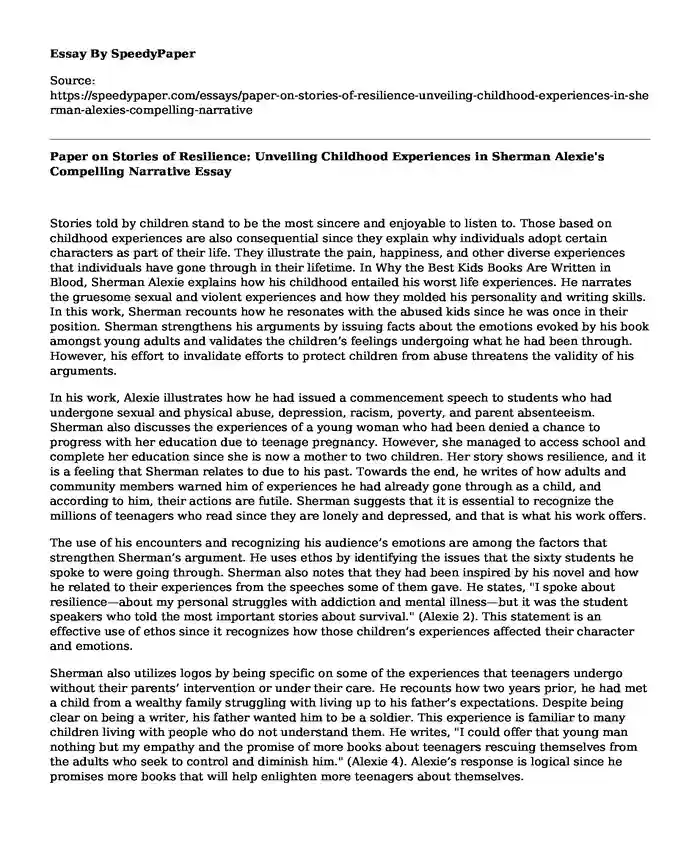
| Type of paper: | Essay |
| Categories: | Students Childhood Emotional intelligence |
| Pages: | 3 |
| Wordcount: | 745 words |
Stories told by children stand to be the most sincere and enjoyable to listen to. Those based on childhood experiences are also consequential since they explain why individuals adopt certain characters as part of their life. They illustrate the pain, happiness, and other diverse experiences that individuals have gone through in their lifetime. In Why the Best Kids Books Are Written in Blood, Sherman Alexie explains how his childhood entailed his worst life experiences. He narrates the gruesome sexual and violent experiences and how they molded his personality and writing skills. In this work, Sherman recounts how he resonates with the abused kids since he was once in their position. Sherman strengthens his arguments by issuing facts about the emotions evoked by his book amongst young adults and validates the children’s feelings undergoing what he had been through. However, his effort to invalidate efforts to protect children from abuse threatens the validity of his arguments.
In his work, Alexie illustrates how he had issued a commencement speech to students who had undergone sexual and physical abuse, depression, racism, poverty, and parent absenteeism. Sherman also discusses the experiences of a young woman who had been denied a chance to progress with her education due to teenage pregnancy. However, she managed to access school and complete her education since she is now a mother to two children. Her story shows resilience, and it is a feeling that Sherman relates to due to his past. Towards the end, he writes of how adults and community members warned him of experiences he had already gone through as a child, and according to him, their actions are futile. Sherman suggests that it is essential to recognize the millions of teenagers who read since they are lonely and depressed, and that is what his work offers.
The use of his encounters and recognizing his audience’s emotions are among the factors that strengthen Sherman’s argument. He uses ethos by identifying the issues that the sixty students he spoke to were going through. Sherman also notes that they had been inspired by his novel and how he related to their experiences from the speeches some of them gave. He states, "I spoke about resilience—about my personal struggles with addiction and mental illness—but it was the student speakers who told the most important stories about survival." (Alexie 2). This statement is an effective use of ethos since it recognizes how those children’s experiences affected their character and emotions.
Sherman also utilizes logos by being specific on some of the experiences that teenagers undergo without their parents’ intervention or under their care. He recounts how two years prior, he had met a child from a wealthy family struggling with living up to his father’s expectations. Despite being clear on being a writer, his father wanted him to be a soldier. This experience is familiar to many children living with people who do not understand them. He writes, "I could offer that young man nothing but my empathy and the promise of more books about teenagers rescuing themselves from the adults who seek to control and diminish him." (Alexie 4). Alexie’s response is logical since he promises more books that will help enlighten more teenagers about themselves.
Throughout this work, Sherman utilizes pathos, and it ensures that he evokes the reader’s emotions. Towards the end, Sherman gives the reader a vivid description of what some children feel when their ambitions are limited by adults who are ignorant of what inspires them. He notes, "They read because they believe, despite the callow protestations of certain adults, that books-especially the dark and dangerous ones-will save them." (Alexie 4). This is an effective use of pathos since it helps the reader understand why Sherman advocates for the arts, which enumerate more on the dark issues that teenagers encounter.
This argument could be made stronger by recognizing more authors who write books that map out teenage experiences. It could also be more robust if the author acknowledges the various institutions that strive to support children and their skills. This conversation should be directed to policymakers in the education sector to ensure that they collaborate with artists to promote creative art. It, therefore, suffices to conclude that, throughout his work, Sherman has effectively utilized ethos, logos, and pathos. This way, readers understand the challenges that teenagers go through while pursuing their dreams.
Work Cited
Alexie, Sherman. "Why the Best Kids Books Are Written in Blood." Retrieved from http://blogs.wsj.com/speakeasy/2011/06/09/why-the-best-kids-books-are-written-in-blood/. 9 June 2011.
Cite this page
Paper on Stories of Resilience: Unveiling Childhood Experiences in Sherman Alexie's Compelling Narrative. (2023, Dec 17). Retrieved from https://speedypaper.net/essays/paper-on-stories-of-resilience-unveiling-childhood-experiences-in-sherman-alexies-compelling-narrative
Request Removal
If you are the original author of this essay and no longer wish to have it published on the SpeedyPaper website, please click below to request its removal:
- Factors That Affect the Level of Political Corruption: Paper Example
- Essay Example on Illegal Immigrants in California
- Paper Example of the Domestic Violence Act and Domestic Violence in Ireland Case Study
- Paper Example. Learning in Other Lands
- Financial Concerns - Essay Sample
- Essay Sample on Research Method and Design
- Who Should Govern Kashmir - Paper Sample
Popular categories




